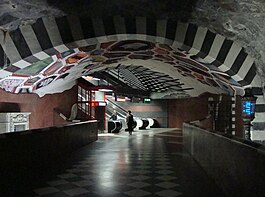The Blue line (Swedish: Blå linjen; officially Metro 3, but called Tub 3 ("Tube 3", or abbreviation for "Tunnelbana 3") internally) is one of the three Stockholm Metro lines. It is 25.5 kilometres (15.8 miles) long, and runs from Kungsträdgården via T-Centralen to Västra skogen where it branches in two, and continues to Hjulsta and Akalla as lines 10 and 11 respectively.
History
Groundbreaking occurred on 2 September 1966 and the line was opened nine years later on 31 August 1975, between T-Centralen and Hjulsta via Hallonbergen. On 5 June 1977, the branch from Hallonbergen to Akalla opened, and on 30 October the same year, the line was extended in the opposite direction from T-Centralen to Kungsträdgården. The next section opened, on 19 August 1985, was between Västra skogen and Rinkeby via Sundbybergs centrum. At that time, line 10 was diverted over this section, and no more passenger trains operated on the Hallonbergen–Rinkeby section. Since then, the section has only been used for access to the depot in Rissne.
The primary reason for constructing the line was the need for public transport to serve the newly-built large residential areas in the northwestern part of Stockholm, built during the period 1965–1975. Several of these areas, however, were without rapid transit during the first years because the opening of the metro was delayed until 1975. During those years Tensta and Rinkeby were served by feeder buses from Spånga station.
The blue line was more costly to build than the previous lines because the general requirements for building design increased over the years. The total cost of the Blue Line was approximately 1.4 billion kr in 1975 currency.
Opening dates
| Section | Date |
|---|---|
| T-Centralen–Hallonbergen–Hjulsta | Sunday 31 August 1975 |
| Hallonbergen–Akalla | Sunday 5 June 1977 |
| T-Centralen–Kungsträdgården | Sunday 30 October 1977 |
| Västra skogen–Sundbybergs centrum–Rinkeby | Monday 19 August 1985 |
| Akalla–Barkarby | (2026) |
| Kungsträdgården–Nacka Kungsträdgården–Hagsätra |
(2030) |
Future plans
Nacka and Gullmarsplan
When the blue line was designed during the boom years of the 1960s, there were also plans to build an extension from Kungsträdgården to Nacka, but they were not realized. However, in 2013, it was decided that the line will run from Kungsträdgården to Nacka centrum via Sofia, Hammarby canal, Sickla and Järla. Construction was expected to have started in 2019 and completed seven to eight years later. A new bus terminal will be built at Nacka centrum to relieve congestion at Slussen for services to different parts of Nacka and Värmdö municipalities.
The transportation review also included an extension from Sofia to Sockenplan, which would include transferring the Hagsätra branch from the Green line to the Blue. The route through the Slakthus area was finalised in May 2015, along with a new underground station to replace Globen and Enskede gård on the Green line. Construction started in 2019, and service is expected to begin in 2030.
Akalla to Barkarby
An extension beyond Akalla was approved for line 11. An intermediate station will serve the new Barkarbystaden residential area, and the line will terminate at the Stockholm commuter rail Barkarby station, allowing revisions to the commuter service. Official groundbreaking took place in September 2018, with completion now scheduled for 2026.
Route
At 25.516 kilometres (15.855 mi), the Blue line is the shortest of the Stockholm metro; however, the entire line is north of the Mälaren. Line 10 runs between Kungsträdgården and Hjulsta and includes 14 stations. Line 11 runs between Kungsträdgården and Akalla and includes a total of 12 stations (ignoring the Kymlinge "ghost station" which was never completed). Six of the stations are served by both lines. The blue line carries an average of about 204,700 passengers per day (2019), or 55 million per year (2005).
Stations
In total, the Blue line has 20 stations, of which 19 are underground and one (Kista) is on the surface. The tunnel between Hjulsta and Kungsträdgården is the longest of the system at 14.3 kilometres (8.9 miles), and is also Sweden's longest tunnel. (However, metro tunnels are usually omitted from lists of the country's tunnels.) Although the Blue line is almost entirely in tunnel, it also has the metro's longest elevated section at Kista, 1,200 metres (3,900 ft) long.
The 11 busiest stations (by number of boardings on a winter weekday in 2019) are:
| Rank | Station | Passengers |
|---|---|---|
| 01 | T-Centralen | 39,800 |
| 02 | Fridhemsplan | 20,250 |
| 03 | Kista | 19,800 |
| 04 | Stadshagen | 14,050 |
| 05 | Rådhuset | 13,100 |
| 06 | Sundbybergs centrum | 12,300 |
| 07 | Solna centrum | 11,400 |
| 08 | Kungsträdgården | 09,850 |
| 09 | Västra skogen | 07,850 |
| 10 | Hallonbergen | 07,350 |
| 11 | Tensta | 06,350 |
References
- ^ "Fakta om SL och regionen 2019" [Facts about SL and the Region 2019] (PDF) (in Swedish). Storstockholms Lokaltrafik. pp. 51, 66–67. Archived (PDF) from the original on 27 December 2020. Retrieved 3 April 2021.
- Trafiksäkerhetsinstruktion för tunnelbanan, ändringstryck 6 (SL-2008-16140) [Traffic Safety Instruction for the Metro, revision 6] (in Swedish) (5.0 ed.). Stockholm, Sweden: Storstockholms Lokaltrafik. 2008.
- Per Sillén (7 December 2011). "Berlin Hauptbahnhof". SJK Postvagnen (Forum posting) (in Swedish). Svenska Järnvägsklubben.
Stockholms tunnelbanor 1975 [Stockholm's Subways 1975] (in Swedish). - ^ "Blå linje till Nacka" [Blue line to Nacka]. Region Stockholm (in Swedish). Stockholm, Sweden. Archived from the original on 2016-09-03. Retrieved 2020-07-30.
- ^ "Nytt om Tunnelbana till Nacka och söderort" [News about Subway to Nacka and southern town] (PDF). Region Stockholm (in Swedish). Stockholm, Sweden: Stockholm County Council. July 2016. Retrieved 2020-07-30.
- "Tunnelbana till Barkarby" [Subway to Barkarby]. Stockholms läns landsting (in Swedish). Stockholm County Council. Archived from the original on 2016-08-19. Retrieved 2016-07-24.
| Lines |
| ||||||
|---|---|---|---|---|---|---|---|
| Stations |
| ||||||
| Rolling stock |
| ||||||
